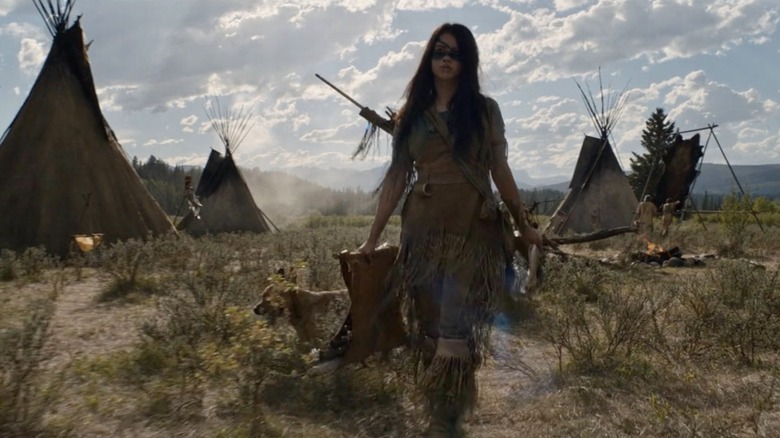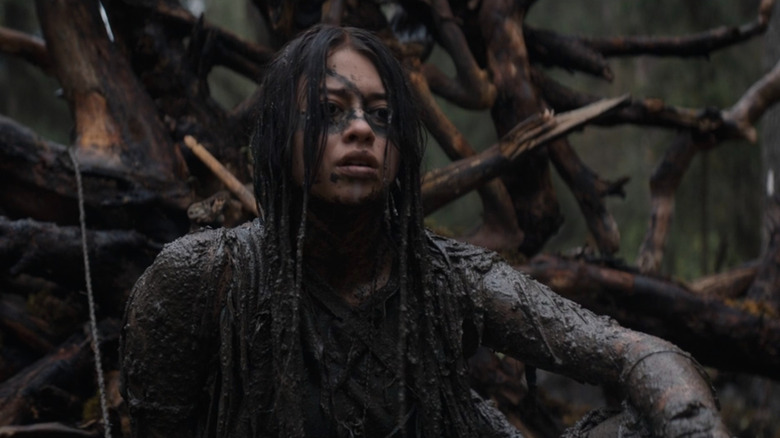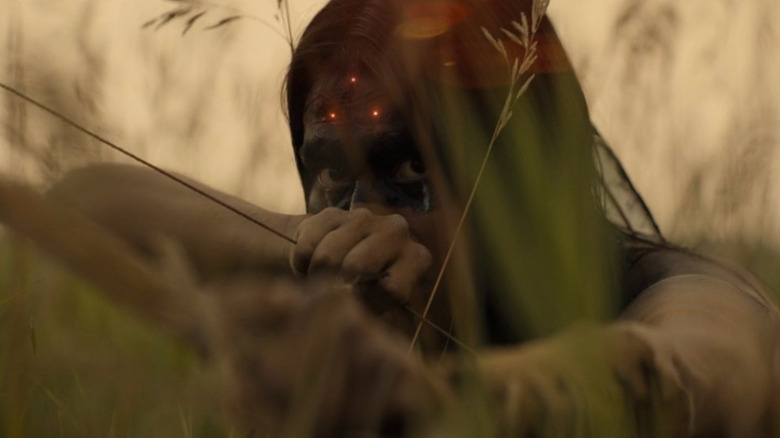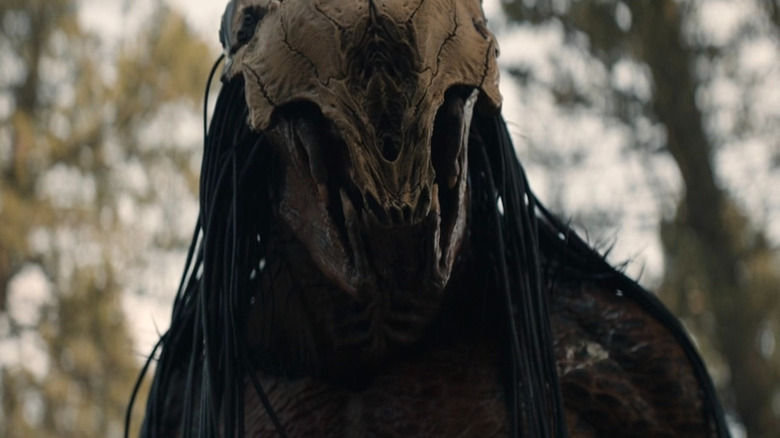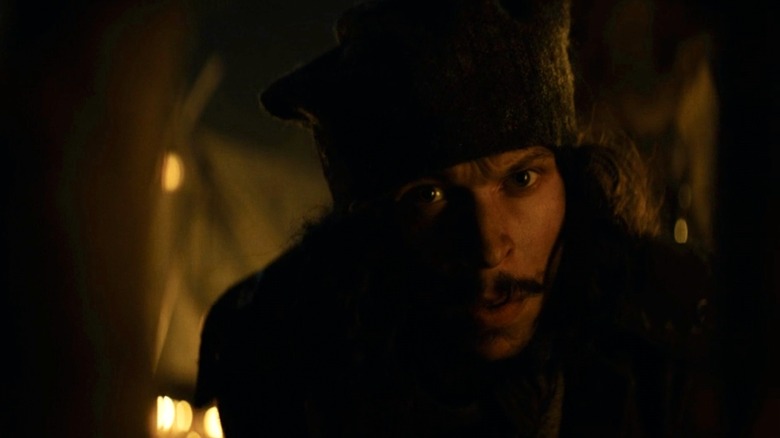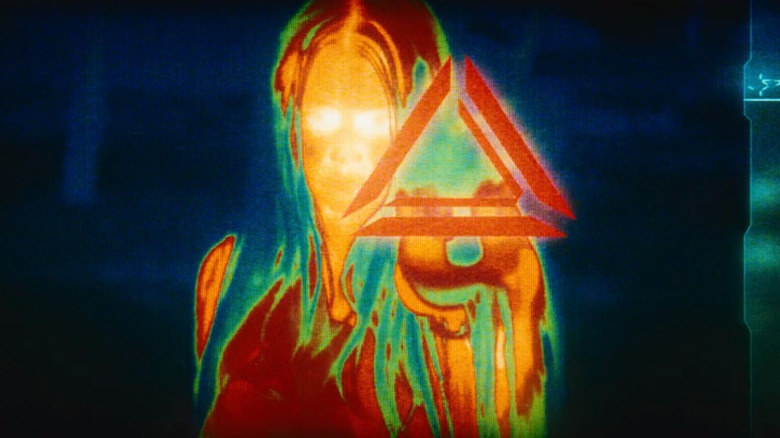Prey Spoiler Review: There's A New Predator At The Top Of The Food Chain
In "Prey," there's a scene where a mouse eats an ant, only to be devoured by a rattlesnake, which, in turn, is impaled by the twin wrist-blades of an invisible-cloaked Predator. It's what the movie itself does to other inferior specimens in the "Predator" franchise. This ain't your grandma's circle of life. Against all odds, writer Patrick Aison, director Dan Trachtenberg, and the "Prey" cast and crew have managed to come along 35 years later and deliver a film that's every bit worthy of the original "Predator."
This sounds easier than it really is. In the age of belated legacy sequels, few movies have been able to truly justify their existence by equaling or bettering the original. The only immediate example that comes to mind is "Fury Road," released 30 years after the last "Mad Max" movie. For its part, "Predator" was always one of those franchises like "Jaws," where the original was in a class by itself while the sequels just sort of sat there on the shelf.
Even as a middle schooler, I was hearing from friends at sleepovers that "Predator 2" wasn't as good as the first movie (though it didn't stop me from staying up and watching it, and the movie earned points for creativity with its city conceit and choice of trophy skulls). The follow-ups "Alien vs. Predator," "Predators," and "The Predator" were all movies I watched once, then promptly forgot.
To say that "Prey" is the best "Predator" movie since 1987 has the ring of a hollow compliment, since it's the sort of chatter we've heard about lesser films in other franchises. While not without a couple of minor hiccups, this is the kind of flick that makes you wonder why no one had the idea to do something like it sooner. Spoilers follow.
Ready to hunt
Conceptually, "Prey" is brilliant. Set in the highly specific time and place of the Northern Great Plains, September 1719, the movie immerses us in a different hunting culture and shows that there's more to the franchise than beefcakes in jungle fatigues. The "Predator" series has been to Antarctica (in its crossover with "Alien"), but imagine if they'd made a movie before this with Inuit hunters facing off against a Predator in a snowy Arctic setting.
"Prey" works best in its wordless stretches, as it unfolds visually and we get to know and survive with Amber Midthunder's Comanche protagonist, Naru. There's very little dialogue in the first few minutes as Naru practices tomahawk-throwing and hunts with her dog Sarii. The point where the movie really had me was when she sees the "Thunderbird" in the clouds and the title, "Prey," slides down onscreen. That was when the bear trap closed around my tail and I knew I was in good hands, or at least had reason to hope.
Naru is very much an empowered, modern movie woman inserted into the patriarchal past, but when you're watching "Prey" in Comanche, it's less noticeably anachronistic in its treatment of her struggle to prove herself amid rampant sexism from male tribal members. "Why do you hunt?" asks her mother Aruka (Michelle Thrush), and without missing a beat, Naru replies, "Because you all think that I'll fail." Later, she tells Sarii, the only sane creature who will listen, "If they don't see, show them." Toward the end, Naru observes that what makes her dangerous is that she's not considered a threat.
Moments like this make her a relatable protagonist beyond gender lines inasmuch as she could just be any underestimated person with a defiant streak. This is an individual who knows she's capable, but she suffers defeat early on when her trial hunt ends with her falling from a tree and hitting her head on a rock.
Hunting the hunter
"Prey" is a lean-and-mean, 100-minute actioner, but Sarah Schachner's music and Jeff Cutter's cinematography layer it with rich, drama-like texture. The movie excels in recapturing — without simply rehashing — the spirit of OG "Predator," that feeling that "there's something in those trees," hunting you in the wild. It does, at one point, bust out a callback to the classic '87 line, "If it bleeds, we can kill it," but if playing the hits is a must, this brief encore is certainly better than having Naru look at the Predator without his new skull mask and say, "You are one ugly motherf*****!"
It's a cool twist on the mythos to have the human hero engaged in a Comanche rite of passage "to hunt something that's hunting you." This starts with a mountain lion ("with teeth like arrows"), which Naru's brother, Taabe (Dakota Beavers), manages to catch and kill using her plan, thereby stealing her thunder.
Dane DiLiegro's Predator, whose weapons technology is less developed in a manner befitting this dot on the timeline, gives new meaning to dancing with wolves. He's more likely to remove one's head and spinal cord than frolic with it in the grass. The Predator's fight with a bear is a barnstorming scene that shows how fearsome it is yet also potentially vulnerable and indeed capable of having its green blood shed.
The first "Predator" movie was steeped in testosterone and bulging biceps, but it's old enough now that someone who was born the year it came out would be of age to run for president instead of just governor like Arnold Schwarzenegger and Jesse Ventura. It's fully possible there might be a new generation of Hulu viewers who are having their first exposure to this franchise through "Prey," but the movie gives the audience all the information it needs to understand its central monster.
When CG animals (and dual languages) attack
"Prey" is teeming with animals, and I've seen some audience reviews that were critical of its CGI. But as a viewer sympathetic to the plight of both animal actors and VFX artists, I'm personally inclined to overlook that issue as the inevitable byproduct of a streaming budget. The alternative would be to use (and risk abusing) live animals and/or give this thing a blockbuster budget and send it to theaters (which 20th Century Studios probably should have done, but that's a moot point at this stage).
I watched "Prey" twice over the weekend — first in English, then in Comanche — and came away with a firm preference for the Comanche version. The only reason I went with English first is because I couldn't find the Comanche version; it was hidden under "Extras" and not part of the regular menu of language and subtitle settings where I streamed it (on Disney+, outside the U.S.)
The best of all possible "Prey" versions in the best of all possible worlds would be one filmed in Comanche with the option for English dubbing, not vice versa. As it is, some of the dialogue is in Comanche already, and when the characters are speaking English, the camera isn't always on their mouth. This minimizes the damage of the dubbing effect, whereby the viewer becomes distracted by the fact that the actors' lip movements don't match the rhythm of their dialogue. It's part of what makes a movie like "Yojimbo" flow better than its out-of-sync Spaghetti Western remake, "A Fistful of Dollars."
That said, "Prey" was shot mostly in English, and the biggest sticking point for me when I watched it under that default setting was its inconsistent, or at least freeform, approach to spoken language. Having seen Midthunder on FX's "Legion," it took me out of the movie sometimes to hear her and other characters reverting to casual English.
'The Hunt for Red October thing'
In "Prey," you have characters slipping in and out of Comanche and English — which is fine. It would have been great to see a film like this commit to the Comanche-language bit instead of resorting to half-measures, but I had no problem accepting that what I was hearing via the actors' flat 21st-century accents wasn't really English, but rather Comanche translated by the movie gods, the way it would be if "Prey" were a comic book with English in angle brackets to denote foreign-language dialogue.
What threw me off was when the French fur traders arrive and take Naru captive. They speak French without subtitles, but they have an interpreter with a familiar flintlock pistol, Raphael Adolini (Bennett Taylor), who launches right into English with Naru. He says, "I speak a lot of languages. You are Comanche, yes?"
Maybe we're just meant to understand he's speaking Comanche and it's being auto-translated for us, too. Yet it almost comes off like "Prey" is suddenly asking us to believe Naru is bilingual and she actually is running around speaking English with contemporary diction in the 1700s.
I found myself thinking of other period pieces with Indigenous actors that were able to pull off non-English dialogue with subtitles. This isn't limited to dramas but would even extend to a 16-year-old action-adventure film like "Apocalypto."
Trachtenberg has admitted that the creative team behind "Prey" "did wrestle a lot with doing a 'Hunt For Red October' thing," whereby Russian gives way to bracket-style English. Producer Jhane Myers, who is Comanche, has also said she hopes "Prey" will inspire future films with a Native narrative to "go the whole mile and do the film in that language." In the meantime, having any Comanche option at all is a big step forward for that particular language.
Hits the target
The fur trappers, with their trail of skinned buffalo and propensity for torturing Native Americans, get what's coming to them, while Chekhov's quicksand (or quick-mud) comes back into play at the end to help save Naru from certain death. It's never in doubt that most of the men in "Prey," even the good ones like Taabe and Raphael, will die, but Trachtenberg does here what he did with "10 Cloverfield Lane" insofar as he makes the movie good enough to keep it essentially spoiler-proof.
"Prey" contains similar sci-fi horror genre thrills as Trachtenberg's 2016 film, and it makes Naru the final girl out in the wilderness before having her come back to her tribe and assume a leadership role — with others finally recognizing that she's got the goods to be more than just a medicine woman. It's a testament to Trachtenberg's filmmaking skills that he's able to keep things engrossing enough that you forget they're following a certain template.
While the Predator may miss his intended target and accidentally murder himself, the movie doesn't. The closing credits, done in the style of Plains Indian ledger art, also give an intriguing tease of other Predator ships coming to Earth. That could mean the door is open for a sequel, but I almost think it would be better if they just left it at that and set the Predator down in a different culture next time, as they did here.
Off the top of my head, the only other streaming movie I've liked enough this year to watch twice the weekend of its release was "The Tragedy of Macbeth." Congratulations, "Prey" team: you've made a movie as rewatchable as a Joel Coen film. "Prey" makes other "Predator" movies look like lion scat. No longer is it necessary to view every fifth franchise entry or prequel with the skepticism of a jaded moviegoer who has seen it all, and much of it done wrong, before. In a time of tentpoles built on tired ingredients, "Prey" stands as a revelation.
